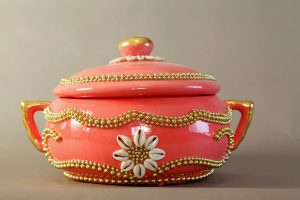Noah Stommel
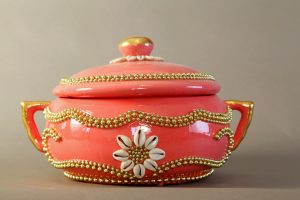
Obba Soup Tureen
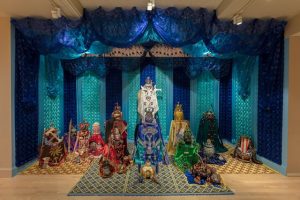
Santeria Birthday Altar
In a corner dedicated to gender representation in Yoruba religion at the Fleming Museum’s Spirited Things exhibit, alone sits a highly decorative Cuban Santeria soup tureen dedicated to the goddess Obba. As the plaque next to the tureen states, legend has it that this Orisha, the goddess of domestic duty and marriage, was tricked by her co-wife to Shango, the Orisha of thunder, to cut off her ear and serve it to him in a stew to win his affection. The soup tureen as an object of worship therefore seems ironically fitting. From an aesthetic standpoint, the tureen appears to be made out of a shiny ceramic material, and is painted bright pink. Both side handles and the single handle on the lid are embellished with gold paint. Strings of threaded golden beads adorn the tureen’s sides, and on opposing sides, as well as around the top handle, cowrie shells are glued to form stars. At the center of the opposing stars lie even more threaded beads.
Cuban Santeria is a religion syncretized between Catholicism brought to Cuba by Spanish colonists, and African-diasporic religion, introduced to the island through the African slave trade (Clark 2001, 21-22). The use of the soup tureen in Santeria has adapted from its origins in West Africa due to the influence of this religious syncretism, which is the fusing of religions to form a new one (Johnson 2016, 760-761). However, through further examination of this tureen, it becomes apparent to me that its use is more so influenced by Yoruba-derived practices than by Catholicism.
The Catholic and Yoruba influences that both play at shaping this object’s purpose and activation methods was part of what captured my interest in this object. I believe that due to cultural mixing on the island of Cuba, there is much to be understood about the true purpose and meaning behind such a soup tureen. Aside from the tureen’s beauty, its lack of ritualistic context in the museum drew me in further. Obba’s tureen was placed closely to the Santeria birthday altar (also pictured), which, as the museum plaque indicates, includes several soup tureens or “soperas” richly decorated with objects made to invoke the presence of other Orisha, or gods, in Yoruba religion. Crucial factors of this altar are varying elevations of the soperas as well as color and the use of other objects with symbolic meaning. Obba’s tureen had a contrasting lack of context. Simply sitting in a display case, I wanted to learn more about the potential for forces to be activated within it, stimulating the presence of Obba, and fulfilling its use as a ritualistic object. In my essay, I will first explain the origins of such an object as seen in West Africa, the homeland of Yoruba religion. Then I will go into depth on how Yoruba religion has combined Catholic traditions to form the practices we see in relation to this object in Cuban Santeria today. Ultimately, I hope to prove that although Catholicism does play a role in Santeria, Yoruba religion continues to be the chief influence in Santeria and the use of that religion’s divining objects.
On their forced journey across the Atlantic, Yoruba people encountered a huge change in setting that required their religion to adapt. This adaptation meant that although much of the basis of the religion stayed the same, certain rituals had to be altered to better fit their new environments. This theory applies to Obba’s soup tureen, not just with the exterior aesthetic, but also with what lies within; consecrated shells or stones “fed” animal blood and herbs (Martin & Luis 2012, 164). The significance of these stones is that they “represent the living presence of the Orisha on the Santeria altar. Like the consecrated host that Catholic doctrine deems the actual body of Christ, these ‘stones’ are the Orisha” (Clark 2001, 37). This parallel seen between Santeria and Catholicism is a prime example of European influence in Cuba. However, while we see Catholicism affecting the contents of the tureen, the overall purpose and idea of spirit activation associated with such an object is still largely a product of Yoruba religion (Bascom 1950, 66-67). In fact, practitioners of Yoruba religion use containers and vessels in their faith as symbols of generosity, respect, and honor to the Orisha (Thompson 1983, 13). Furthermore, it is important to note the orientation of Santeria around African-inspired Orisha (Bascom 1950, 64), and not one central Christian God. The fact that Yoruba customs live on in Santeria, despite competing Catholic contribution, indicates the preservation of native African culture.
Further important to Santeria rituals are palm nuts, cowrie shells, and water. This can therefore account for aspects of the decorum present on the outside of the tureen. These elemental factors, in combination with herbs, blood, and stones breathe a life force, known to Yoruba practitioners as “Ase,” into the tureen, which is necessary both for life and for performing religious rituals (Brown 79). A byproduct of Yoruba religion seen in Santeria is the requirement of Orisha to manifest themselves on Earth in containers or vessels, where they can reside. Human bodies and drums can also serve as a vessel for Orisha habitation (Murphy 2012, 79-80). The color aesthetics of the Orisha’s containers is also highly meaningful in Santeria.
The color scheme of Obba’s soup tureen is explained as being highly dependent on the individual beliefs that Santeria practitioners have on the color preferences of the Orisha themselves. One practitioner explained that for her, “Obba wears yellow and white beads for no other reason than ‘that’s the way I received it’” (Brown 1996, 99). Granted that there are some guidelines to color representation of the Orisha, this is a mentality held greatly by Yoruba practitioners, for whom there is not a particularly dictating religious code of worship that must be followed (Brown 1996, 100). Of course, Christianity also allows for a level of interpretation of religion among its followers, so while the colors representative of Obba are heavily influenced by Yoruba, the basis of individual interpretation could find itself in either religion.
A highly possible explanation for syncretic imbalances associated with Obba’s tureen is that throughout the colonial era, there were many instances of Santeria being oppressed by the dominant European society. This theme is seen “everywhere across the early black Americas [because] covert altars encoded the richness of sacred memory to unite servitors in sustaining faiths” (Thompson 1993, 21). By veiling one’s African-derived religious practices behind a Catholic pretense, Santeria worshippers were able to preserve their rituals and beliefs, even while under the watchful eyes of the Catholic Church.
Some scholars on African-diasporic religions argue that there is a scholarly bias in classifying Santeria as a byproduct of Catholic syncretism. They state that “the origin of this religion is in the forests of the country previously called Yorubaland, better known today as Nigeria. From there comes what we today know as Santeria” (Fardon 1995, 83). Adding to this belief is the fact that “Spanish law insisted that slaves be baptized as Roman Catholics as a condition of their legal entry into the Indies” (Murphy 1988, 27). The forceful integration of Yoruba people in a Catholic-dominated society, although influential on the resultant Santeria, would not have created the desire to assume the practices and values held by oppressors. It is more plausible to argue that “Caribbean religions such as Santeria… are often cited as examples of syncretism because the religions involved have such different histories and because the historical materials about them are relatively recent and full” (Murphy 1988, 120). There is no avoiding the fact that Catholicism and Yoruba religion mixed to produce Santeria, but it is reasonable to suggest that given the belief systems held by a vast majority of those enslaved in Cuba, an emphasis on Yoruba religion was preserved in the island’s Afro-Caribbean culture.
As I came to learn through my research of Obba’s tureen, there is a definite degree to which syncretism of Catholicism and Yoruba religion has had on the overall use of the Obba’s tureen, as well as Santeria itself. However, I would assert that there is still more of a Yoruba emphasis in the aesthetics of Santeria soperas, an essential counterpart of the greater religion. Through information provided on how Yoruba beliefs maintained a tight grip over incoming slaves transported from Africa, and how European-enforced Catholicism influenced Santeria practice, the predominant influences on modern usage of Obba’s soup tureen have become clearer. This syncretized religion shows its true colors in both the objects that it so highly regards in worshipping the Orisha, and in aspects of the theological belief system. I believe that this trend of religious mixture makes itself apparent not only in Santeria, but in all other New World African religions, or on a larger scale, any religion whose followers have undergone voluntary or forced cultural coalescence.
Now that I have come to understand the context of the animation and aesthetics of the tureen, I am more interested than ever to witness the process of stone consecration and the subsequent activation of Obba. When first viewing this object, my interest was sparked by its placement in the museum, relatively isolated from others that serve a similar purpose. I believe that this therefore served as a basis to learn more about other objects of its like, and the human history that has forced its adaptation.
Bibliography
Bascom, William R. “The Focus of Cuban Santeria.” Southwestern Journal of Anthropology 6, no. 1 (1950): 64-68.
Brown, David H. “Toward an Ethnoaesthetics of Santeria Ritual Art: The Practice of Altar-Making and Gift Exchange.” Santeria Aesthetics in Contemporary Latin American Art (1996).
Clark, Mary A. “”¡No Hay Ningún Santo Aqui!” (There Are No Saints Here!): Symbolic Language Within Santeria.” Journal of the American Academy of Religion 69, no. 1 (2001): 21-41.
Duke University . “Soup-Tureen Altar Vessel (Sopera) for the Santeria/Ocha Goddess Obba.” Accessed November 5, 2017.
Fardon, Richard, ed. Counterworks: Managing the Diversity of Knowledge. New York: Routledge, 1995.
Johnson, Paul C. “Syncretism and Hybridization.” In The Oxford Handbook of the Study of Religion, edited by Michael Stausberg and Steven Engler, Oxford: Oxford University Press, 2016.
Jones, Rachel E. “Art Review: ‘Spirited Things: Sacred Arts of the Black Atlantic,’ Fleming Museum.” Seven Days, October 4, 2017.
Martin, Oba F., and William Luis. “Palo and Paleros: An Interview With Oba Frank Martin.” Afro-Hispanic Review 31, no. 1 (2012): 159-68.
Murphy, Joseph M. “Chango ‘ta vein’/ Chango has come”: Spiritual Embodiment in the Afro-Cuban Ceremony, Bembé.” Black Music Research Journal 32, no. 1 (2012): 69-94.
Murphy, Joseph M. Santeria: An African Religion in America. Boston: Beacon Press, 1988.
Thompson, Robert F. Flash of the Spirit: African & Afro-American Art & Philosophy. New York: Random House, Inc., 1983.
Thompson, Robert F. “Overture: The Concept “Altar”.” Face of the Gods: Art and Altars of Africa and the African Americas (1993).
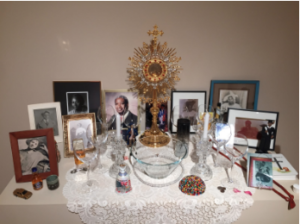
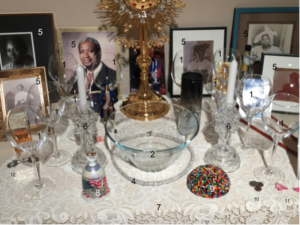 The syncretic qualities of Spiritism allow us to gain an understanding of where certain Spiritist values are derived from. Spiritism is oriented around communication with ancestors that often takes place in the form of spirit possession (Bettelheim 314-315, 2005). Interestingly, this core value of Spiritist belief in communication with ancestors is believed to have been a result of syncretization with Native American cultures (Romberg 70,1998). In connection to syncretization, altar construction is considered “fluid, mixing a variety of religious systems and iconographies and inventing new ones” (Bettelheim 314, 2005), hence the inclusion of objects of apparent Christian origin, like Object 3 on Professor Matory’s altar. An element of these altars that is chiefly Spiritist is the horizontal layout as represented by Object 7. As a practitioner becomes more experienced, the altar will become more adorned with objects, often involving portraits of the ancestors who are to be worshipped (Bettelheim 315, 2005). Professor Matory’s altar honors his and his wife’s ancestors, who are rendered present through objects and photos. Continue reading
The syncretic qualities of Spiritism allow us to gain an understanding of where certain Spiritist values are derived from. Spiritism is oriented around communication with ancestors that often takes place in the form of spirit possession (Bettelheim 314-315, 2005). Interestingly, this core value of Spiritist belief in communication with ancestors is believed to have been a result of syncretization with Native American cultures (Romberg 70,1998). In connection to syncretization, altar construction is considered “fluid, mixing a variety of religious systems and iconographies and inventing new ones” (Bettelheim 314, 2005), hence the inclusion of objects of apparent Christian origin, like Object 3 on Professor Matory’s altar. An element of these altars that is chiefly Spiritist is the horizontal layout as represented by Object 7. As a practitioner becomes more experienced, the altar will become more adorned with objects, often involving portraits of the ancestors who are to be worshipped (Bettelheim 315, 2005). Professor Matory’s altar honors his and his wife’s ancestors, who are rendered present through objects and photos. Continue reading 

